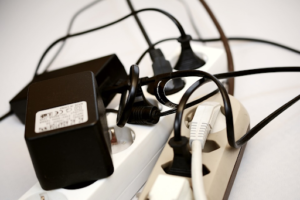Electrical issues should never be dismissed. Your first instinct may be to call in professionals to handle the issue. While you are right to have a licensed electrician check out electrical issues at hand, there are actually a few things you can do as the homeowner to safely troubleshoot, which will save you money if your problem is solved!
1. Is it plugged in? As silly as this may sound, it is always important to double check that your appliance is securely plugged into the outlet. If needed, unplug and replug it into the outlet to see if this is able to solve your problem. Also, if your cord is detachable, double check that it is secured to the device as well.

2. Is your outlet controlled by a switch? If your outlet is controlled by a switch, be sure to check that the switch is turned on.
3. Could there be a faulty socket? There is a possibility that your problem may have nothing to do with your home’s main wiring, but more so with the socket itself. Try to plug your appliance into the other outlet on the same socket to see if this is able to fix your problem.
4. Is the circuit overloaded? It is best to check that outlet and surrounding outlets to make sure that there isn’t too much energy overloading the circuit. Signs to know that you may be overloading the circuit would include noticing flickering lights, a burning smell, buzzing sound from your receptacle, or discoloration on your outlet plate. Make sure that you do not have too many devices plugged in and only turn one on at a time. Be mindful that a power strip will add additional outlets, but will not change that amount of power the outlet receives.
 5. Do you need to reset your GFCI breaker? A GFCI is designed to protect you and prevent an electrical shock. They work as mini breakers by tripping if there are too many things plugged in at once. Try resetting the GFCI outlet by unplugging all devices first. The GFCI will have two buttons between the actual plugs on the outlet. One will say test and the other reset. If the GFCI is tripped you will see a yellow or red light. Press the button with the light to reset the GFCI.
5. Do you need to reset your GFCI breaker? A GFCI is designed to protect you and prevent an electrical shock. They work as mini breakers by tripping if there are too many things plugged in at once. Try resetting the GFCI outlet by unplugging all devices first. The GFCI will have two buttons between the actual plugs on the outlet. One will say test and the other reset. If the GFCI is tripped you will see a yellow or red light. Press the button with the light to reset the GFCI.
6. Are there any tripped breakers in the sub panel? Take a look at your sub breaker panel, usually located in your garage. These breakers tend to be more sensitive to better protect your home. A tripped breaker will trip to the middle, meaning that it is not fully on, but it is not fully off either. When in this position, you still will not receive any power to that circuit. Turn the breaker all the way off and then all the way back on. This should restore the power back to that circuit. If you continue to have issues with a certain circuit, but it is showing that it is on, still flip it off and then on again.

7. Could the tripped breaker be in your main panel? Don’t forget to look in your main panel for a possible tripped breaker as well. This panel is usually located outside near your meter base.
Here at Anchor Electric of Florida Inc. we would be happy to come out and assess the situation to ensure that your power is fully restored and working safely.
Follow us on Facebook or Instagram to learn more!
